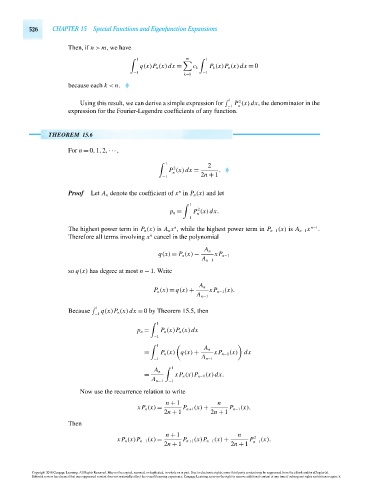Page 546 - Advanced_Engineering_Mathematics o'neil
P. 546
526 CHAPTER 15 Special Functions and Eigenfunction Expansions
Then, if n > m,wehave
1 m 1
q(x)P n (x)dx = c k P k (x)P n (x)dx = 0
−1 −1
k=0
because each k < n.
1 2
Using this result, we can derive a simple expression for P (x)dx, the denominator in the
−1 n
expression for the Fourier-Legendre coefficients of any function.
THEOREM 15.6
For n = 0,1,2,···,
1 2
2 .
P (x)dx =
n
−1 2n + 1
Proof Let A n denote the coefficient of x in P n (x) and let
n
1
2
p n = P (x)dx.
n
−1
n
The highest power term in P n (x) is A n x , while the highest power term in P n−1 (x) is A n−1 x n−1 .
n
Therefore all terms involving x cancel in the polynomial
A n
q(x) = P n (x) − xP n−1
A n−1
so q(x) has degree at most n − 1. Write
A n
P n (x) = q(x) + xP n−1 (x).
A n−1
1
Because q(x)P n (x)dx = 0 by Theorem 15.5, then
−1
1
p n = P n (x)P n (x)dx
−1
1
A n
= P n (x) q(x) + xP n−1 (x) dx
−1 A n−1
1
A n
= xP n (x)P n−1 (x)dx.
A n−1 −1
Now use the recurrence relation to write
n + 1 n
xP n (x) = P n+1 (x) + P n−1 (x).
2n + 1 2n + 1
Then
n + 1 n
xP n (x)P n−1 (x) = P n+1 (x)P n−1 (x) + P 2 (x).
2n + 1 2n + 1 n−1
Copyright 2010 Cengage Learning. All Rights Reserved. May not be copied, scanned, or duplicated, in whole or in part. Due to electronic rights, some third party content may be suppressed from the eBook and/or eChapter(s).
Editorial review has deemed that any suppressed content does not materially affect the overall learning experience. Cengage Learning reserves the right to remove additional content at any time if subsequent rights restrictions require it.
October 14, 2010 15:20 THM/NEIL Page-526 27410_15_ch15_p505-562

